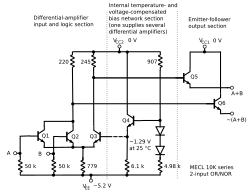Emitter-coupled logic

Imagine two friends playing catch with a ball. One friend throws the ball to the other friend, who catches it and throws it back. They keep doing this back and forth, keeping an even flow of movement.
Now, let's say instead of a ball, they are using electric signals. The first friend sends an electric signal to the second friend, who catches it and sends it back. This happens very quickly and the signal keeps moving back and forth between the two friends.
Emitter-coupled logic (ECL) is a way to make electronic circuits work like our friends playing catch. In ECL circuits, there are two parts called "emitters" that are constantly sending signals back and forth without ever stopping. These emitters are like our two friends playing catch.
The emitters work together to create an electronic signal that can be used to turn on or off other parts of the circuit. Just like how one friend catching the ball allows them to start throwing it back and forth, the emitters working together allows the electronic signal to continue flowing through the circuit.
ECL is a very fast and precise way to make electronic circuits work. Imagine if you could play catch with a ball that could move at lightning speed - that's how ECL works in the world of electronics.
Now, let's say instead of a ball, they are using electric signals. The first friend sends an electric signal to the second friend, who catches it and sends it back. This happens very quickly and the signal keeps moving back and forth between the two friends.
Emitter-coupled logic (ECL) is a way to make electronic circuits work like our friends playing catch. In ECL circuits, there are two parts called "emitters" that are constantly sending signals back and forth without ever stopping. These emitters are like our two friends playing catch.
The emitters work together to create an electronic signal that can be used to turn on or off other parts of the circuit. Just like how one friend catching the ball allows them to start throwing it back and forth, the emitters working together allows the electronic signal to continue flowing through the circuit.
ECL is a very fast and precise way to make electronic circuits work. Imagine if you could play catch with a ball that could move at lightning speed - that's how ECL works in the world of electronics.
